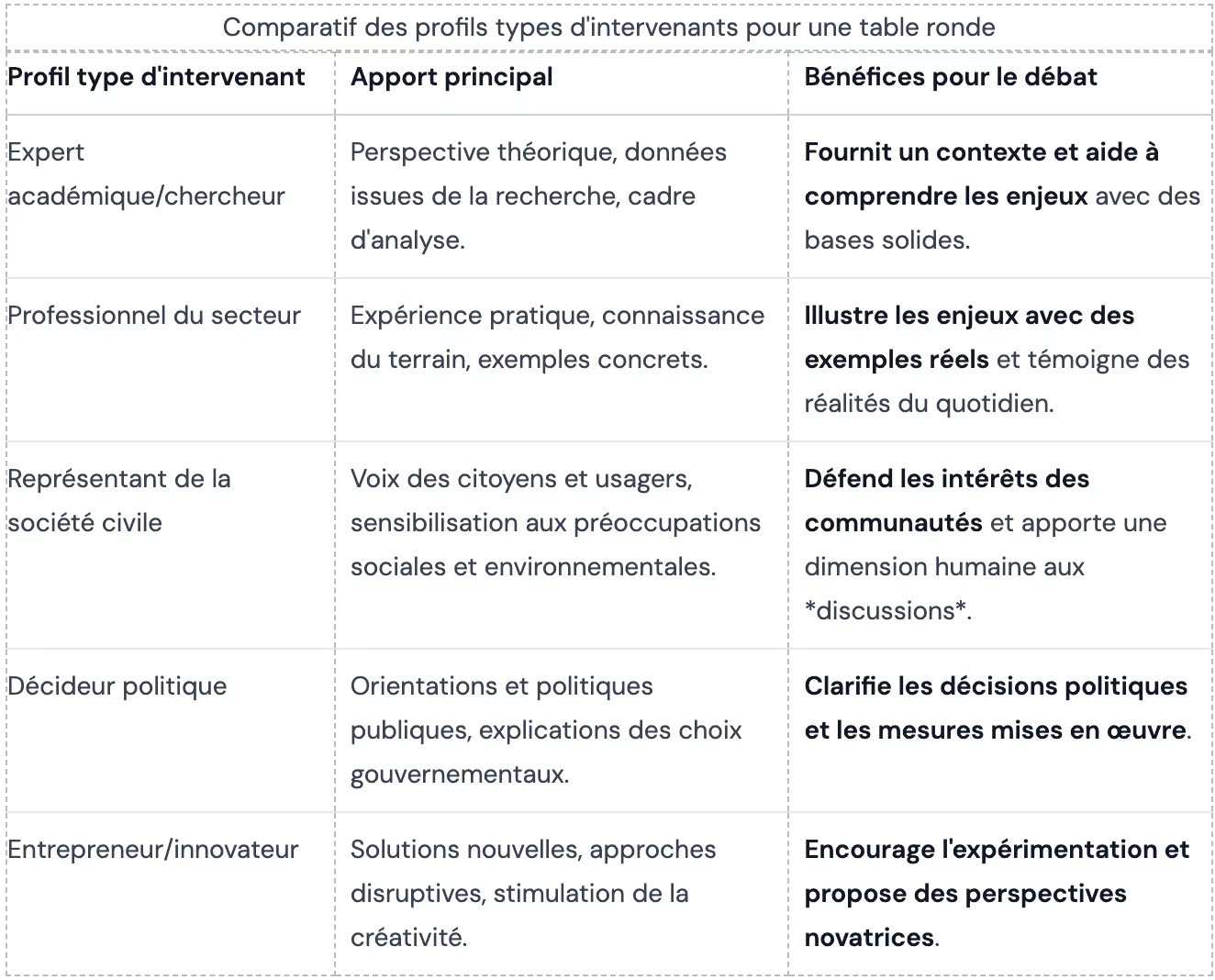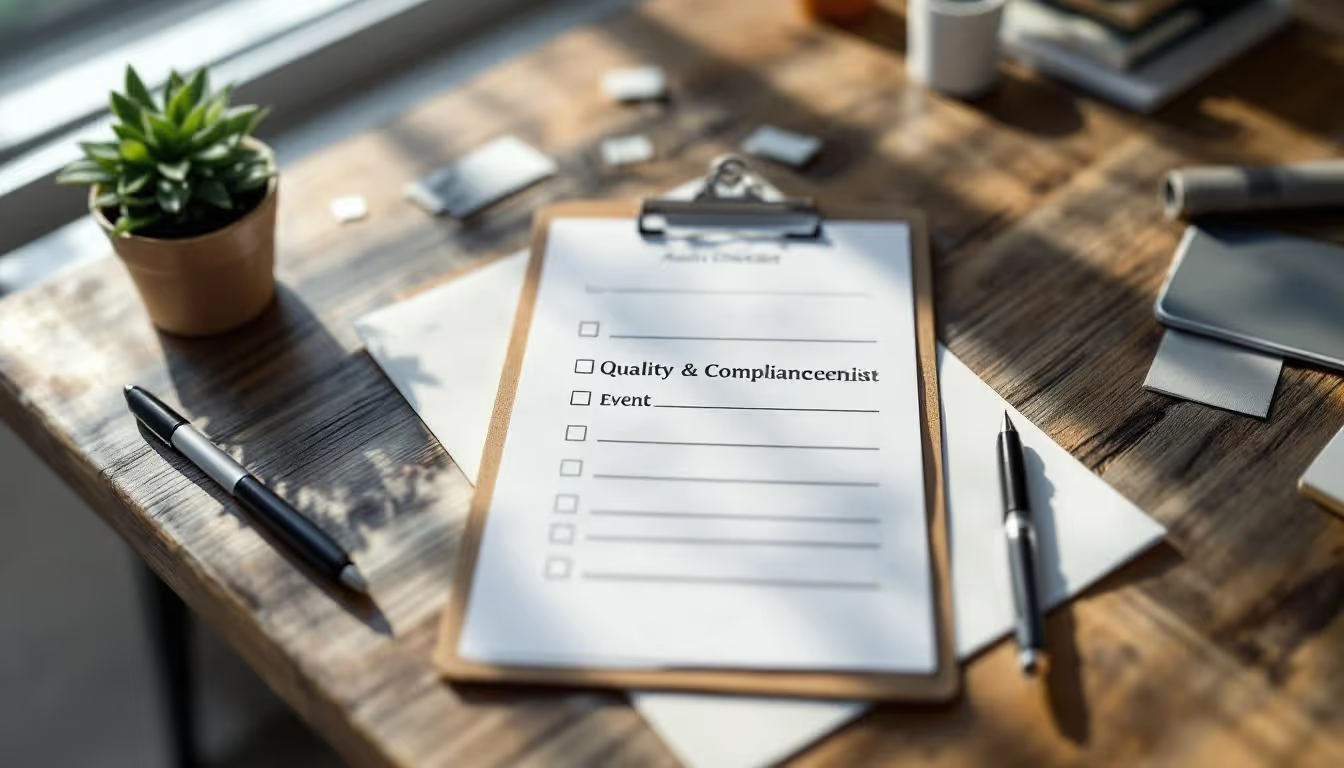Are you looking to organize a panel discussion that really interests your audience and creates concrete exchanges? We guide you step by step here.
We will look together at the key points for preparing a successful event: choice of speakers, facilitation of debates and selection of a promising theme.
So, ready to make your event a truly memorable occasion?
The fundamentals of a successful panel discussion
Define objectives and theme
A well-*defined theme* and concrete objectives remain a key point. It's the foundation for organizing a panel discussion that really works.
Here are five practical steps to structure your topic and capture the interest of participants:
- Interactivity: Opt for a *theme* that encourages discussion. The idea? That the *audience* dares to intervene and share their *ideas*. A good round table thrives on dialogue between everyone.
- Communication: Plan your communication before, during, and after the event. Social networks help to keep the discussions alive longer, even once the *room* is empty.
- Diversity: Mix the profiles of *speakers*. *Different* perspectives on the same subject avoid blind spots and better nourish reflection.
- Preparation: Do not neglect this step. Clear *objectives*, carefully selected speakers, and impactful content often make the difference.
- Innovation: Choose a topic that opens up possibilities. *Round tables* shine when they bring out innovative solutions.
Good to know: to turn your *theme* into useful questions, use neutral language.
A tip? Have someone external proofread your wording.
This allows you to verify that the questions are understandable and do not lead the answers.
Selection of speakers and participants
The balance of the panel of experts is as important as their expertise. The ideal? Vary the skills without forgetting group dynamics.

To involve the public, focus on simple tools. A good *facilitator* knows how to revive discussions and give everyone a chance to speak.
Companies that succeed in their round tables often integrate periods of free intervention - this energizes the debates.
Essential logistical setup
The configuration of the space directly influences interactions. Whether in a circle or a U-shape, the important thing is that everyone feels equally able to participate.
On the tech side, prioritize lean efficiency. As with organizing a corporate after-work event, the equipment should serve the content without complicating the form. A microphone that works well, a stable video connection if needed... and you're good to go!
Professional facilitation techniques
Role of the moderator
To facilitate an effective round table, the facilitation expert must master several skills. I propose to detail the key skills that make the difference during an intervention.
Knowing how to maintain attention requires precise techniques.
Take the example of non-verbal cues: regular eye contact with participants helps to create a connection.
Companies often use this method to facilitate exchanges. An open posture and a few nods naturally encourage participation.
Let's see how to manage speaking time without abruptly interrupting.
Time and speaker management
Structuring the stages of a panel discussion remains fundamental. For example, we will organize sequences with specific objectives. This approach helps companies frame their discussions effectively.
To balance speaking time, the expert can use simple tricks. Asking targeted questions to specific participants often works better than a formal round table.
During a recent intervention, I noticed that calling people by their first name increased contributions. Sensitive topics sometimes require individual speaking times before the collective debate.
Interactive dynamic
Breaking the ice quickly is a crucial step. To animate a group of experts, we will opt for professional icebreakers.
For example: "What question summarizes your vision of the subject?". This technique stimulates discussion without lapsing into inappropriate playfulness.
Reintroducing technical subjects requires finesse. After each major intervention, I recommend summarizing the information in one sentence. Companies appreciate it when they are offered concrete tools to capitalize on these exchanges.
A good expert will know how to alternate between in-depth exploration of ideas and respecting the timing.
Visual aids
Visuals support but do not replace the presentation. During a panel discussion, we limited the slides to a few keywords per screen.
Result: more spontaneous interventions and topics covered.
Beware of technological pitfalls. The expert must test all tools before the intervention. The key is to circulate information effectively between participants.
Optimize audience engagement
To capture attention before an event, tried-and-true methods are often used.
Generating anticipation around a round table requires a rigorous organization of communication channels.
Social networks are a natural relay for building a memorable experience, by connecting physical logistics and digital strategy.
With the proliferation of options, choosing the right media to promote your event becomes critical.
Note that effective event communication is prepared in advance: it must accompany each stage, from launch to post-event review. For companies, this continuous monitoring guarantees success.
During the event itself, interactive techniques make the difference.
The idea? Structure the debate into clear stages to maintain audience engagement.
A successful round table creates a real dialogue between industry experts and participants.
The trick is to liven up the exchanges by varying the formats: open questions, live polls, or feedback. Some use dedicated applications to streamline interaction between speakers and the audience. One avenue to explore: break down the discussion into thematic sequences, providing reaction times after each stage.
It energizes the topics discussed and allows for adjusting the pace.
Capitalize on the results
Content Delivery
To ensure the lasting impact of your round table, let's start by choosing formats tailored to each audience. Companies benefit from varying the media based on their audience's habits.
A detailed report will be more suitable for technical experts, while a concise video will be more effective for busy employees.
The key step here is to match the type of information with the profile of the recipients.
Let's move on to facilitating post-event discussions. Collaborative platforms like Google Workspace or Microsoft Teams help maintain dialogue.
A good practice: structure feedback by specific topics and designate a contact person for each theme.
This moderate intervention prevents the dispersion of contributions.
Let's not forget to integrate this information into a continuous improvement process.
Performance evaluation
Measuring the actual impact requires a two-step approach. First, simple quantitative indicators: participation rate in exchanges, shares on networks.
Then, a qualitative analysis via targeted surveys.
Companies benefit from involving their internal experts to decipher this data - their input often provides valuable insight.
The last step is to transform this information into an action plan. P
rather than aiming for a complete overhaul, I advise you to gradually adjust your next round tables.
For example: reduce the time of presentations to free up interactive exchange.
The key is to maintain a regular pace of iterations while documenting the improvements made.
Mistakes to avoid and best practices
Common pitfalls in organization
We often see 5 recurring mistakes during the preparation phase.
The key point? Anticipate operational risks to ensure an effective round table. Field experts offer concrete solutions to each problem.
You get the idea? A well-prepared plan B makes all the difference.
Let's take a concrete example: imagine a speaker is absent or there is a technical failure. The idea is to plan for quick alternatives to activate.
Backup equipment, an identified replacement, a backup internet connection... This practical information must be clearly shared with all participants.
A successful intervention relies on this upfront preparation.
Trends and innovations
New technologies are changing the game for debates. Professionals know: integrating suitable digital tools is becoming essential. Moreover, the Council of Europe regularly organizes round tables with international experts. A good way to share perspectives on complex subjects.
The current challenge? Adapting the format to the audience's expectations. For businesses, this means blending in-person and remote participation without sacrificing quality.
What works: a high-performance audio/video system and a platform that enables real-time interaction. Don't forget to display remote participants on a dedicated screen.
And in terms of engagement, encourage interactions via chat or direct questions. A successful intervention creates connection despite the distance.
Inspiring feedback
Analyzing impactful round tables provides valuable insights. Experts advise drawing inspiration from this feedback while adapting the methods to your context.
A crucial point? Understanding the precise expectations of your audience before launching.
Specifically, this involves several steps: identifying topics that are genuinely interesting, choosing relevant speakers, and testing innovative formats. Successful companies always add a personal touch.
For example, using interactive engagement techniques even with budget constraints.
Interaction between participants remains at the heart of the process, regardless of the configuration.
By mastering these key steps, you have an effective guide for truly relevant exchanges during your events.
Don't delay in organizing your round table: it's the best way to bring fresh ideas out of your discussions.
A guarantee of success for presentations that leave a lasting impression.




